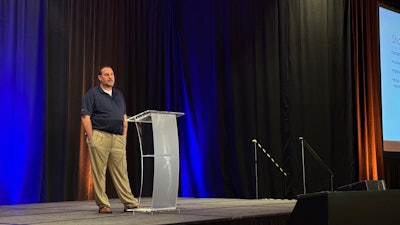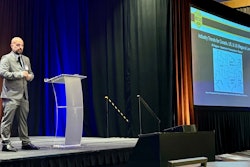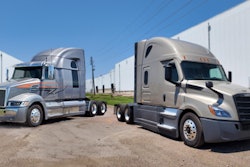
Shane Carder from MHC Kenworth has seen both sides of the repair process and offered HD Repair Forum attendees in Frisco, Texas, advice on moving the process along.
[RELATED: Mining the stats yields insights for HD Repair Forum attendees]
He recommends good communication and, when necessary, do a little education. That may mean a little extra work from the shop, such as preparing two estimates for unrelated damage or for OEM parts, taking dozens of photos of damage and supporting the file in any way you can.
"As shop managers or shop estimators, we are the eyes and ears for the insurance company, essentially," Crader says, and that's even more true now that most adjusters work remotely.
Crader says there's almost always a discussion about repairing versus replacing when it comes to a damaged truck.
"I'm a big repair guy," Crader says. "No offense to the parts people, but I sell labor not parts. I truly like to repair everything that I can."
Quality repairs, he says, can keep a truck from potentially totaling, help train your technicians and generate more business for the shop. It's especially crucial in situations where parts may not be available.
Another opportunity for customer education is preparing estimates with OEM versus LKQ-aftermarket parts. Customers like to insist on OEM parts, Crader says, and advises writing two estimates yet again. One with all OEM parts and one with LKQ or aftermarket parts.
"As a shop, we'll stand behind it both ways," he says.
Shops should also take plenty of supporting photos, Crader says. This means photos from different angles, from close up and far away, with clear views of the odometer and VIN.
"Photos tell the story," he says.
Supplements are also necessary, if loathed, part of the education process.
"Nobody likes them, they're a problem," Crader says. "But they're a necessary evil of what we do."
He says his approach on supplements is the same as when he was a claims adjuster: Build a file. The easiest way for the shop to help the adjuster out is to keep the adjuster updated, especially on the more complex, newer trucks.
Adjusters carry 100-200 claim files, Crader says, and it's helpful to update them once a week to keep everything moving like it should.
Itemizing shop supplies are another good way to keep adjusters and customers informed of what it takes to make a repair. Shops should build a cost sheet and explain the need for each of the listed supplies.
"Shop supplies is the easiest thing to cut from an adjustment because it's vague," Crader says. Itemizing costs are also important because it lets companies know what's needed for repairs.
Teardown inspections are also an opportunity to keep everyone updated and expedite repairs.
"With the newer stuff, it's almost imperative," Crader advises. "It's almost common now to write an $80-$85,000 estimate and the truck be nowhere near totaling."
Crader says if it's that high with stuff that can be seen, there's definitely more damage that's unseen. It also provides an opportunity to expedite the repairs because you can order your parts all at once.
"As the repair shop, we play a crucial role in the HD repair claims process," Crader says. "With proper communication and documentation, we have the opportunity to gain a customer and further build a relationship with the insurance carrier."










